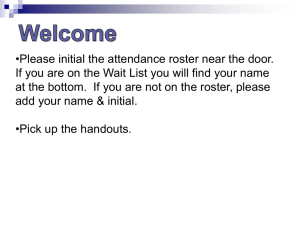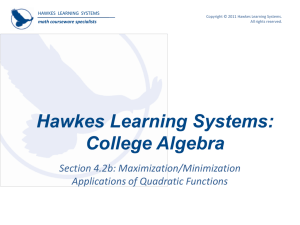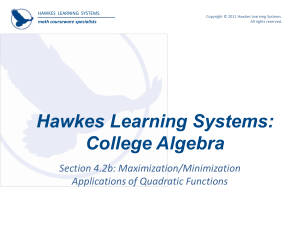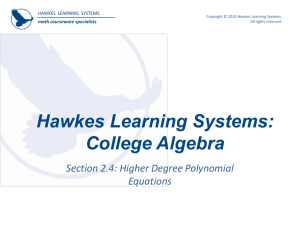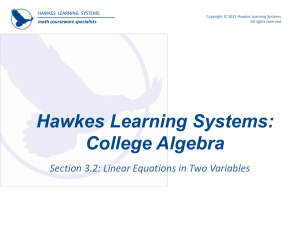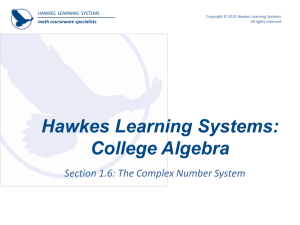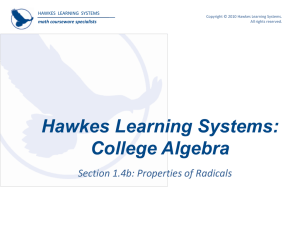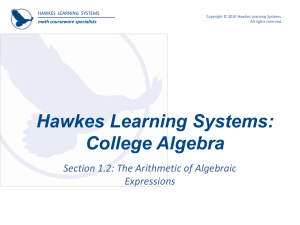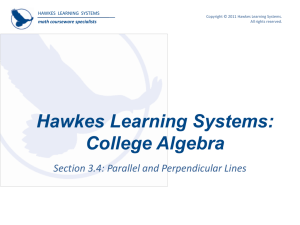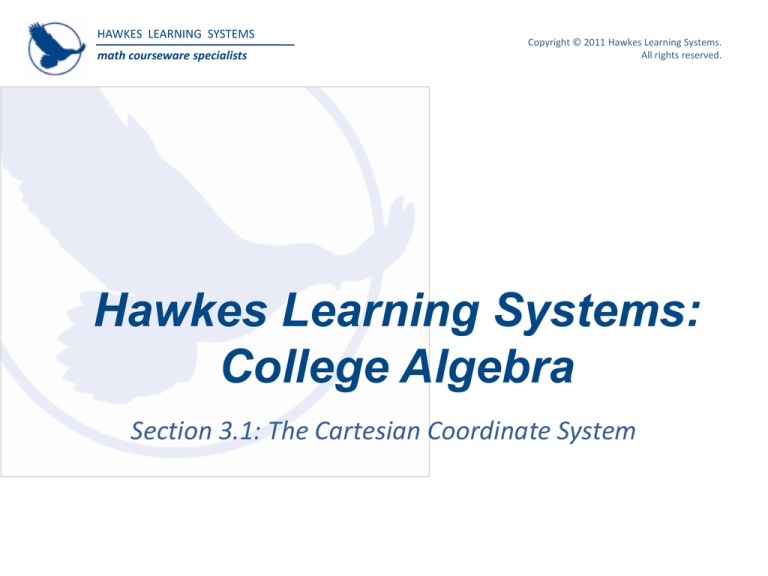
HAWKES LEARNING SYSTEMS
math courseware specialists
Copyright © 2011 Hawkes Learning Systems.
All rights reserved.
Hawkes Learning Systems:
College Algebra
Section 3.1: The Cartesian Coordinate System
HAWKES LEARNING SYSTEMS
Copyright © 2011 Hawkes Learning Systems.
All rights reserved.
math courseware specialists
Objectives
o The components of the Cartesian coordinate system.
o The graph of an equation.
o The distance and midpoint formulas.
HAWKES LEARNING SYSTEMS
math courseware specialists
Copyright © 2011 Hawkes Learning Systems.
All rights reserved.
The Components of the Cartesian Coordinate
System
o Many problems are naturally expressed with two or
more variables. To solve these problems, we must
determine all of the values of the variables that make
the equation or inequality true.
o For example, an equation with the variables x and y
will have a solution consisting of a value for x and a
corresponding value for y . A solution of the equation
cannot consist of a value for only one of the variables.
o Such equations are graphed on a two-dimensional
coordinate system.
HAWKES LEARNING SYSTEMS
math courseware specialists
Copyright © 2011 Hawkes Learning Systems.
All rights reserved.
The Cartesian Coordinate System
The Cartesian coordinate
system, also referred to as
the Cartesian plane or the
rectangular coordinate
system, consists of two
perpendicular real number
lines (each of which is an
axis) intersecting at the
point 0 of each line.
HAWKES LEARNING SYSTEMS
math courseware specialists
Copyright © 2011 Hawkes Learning Systems.
All rights reserved.
The Cartesian Coordinate System
The point of intersection is
called the origin of the
system, and the four
quarters defined by the
two lines are called the
quadrants of the plane,
numbered as indicated on
the graph to the left.
HAWKES LEARNING SYSTEMS
math courseware specialists
Copyright © 2011 Hawkes Learning Systems.
All rights reserved.
The Cartesian Coordinate System
Because the Cartesian
plane consists of two
crossed real lines, it is often
given the symbol ¡ ¡
or ¡ 2.
Each point P in the plane is
identified by a unique pair
of numbers called an
ordered pair.
HAWKES LEARNING SYSTEMS
math courseware specialists
Copyright © 2011 Hawkes Learning Systems.
All rights reserved.
The Cartesian Coordinate System
In a given ordered pair
the first number (the first
coordinate) indicates the
horizontal displacement
of the point from the
origin, and the second
number (the second
coordinate) indicates the
vertical displacement.
HAWKES LEARNING SYSTEMS
math courseware specialists
Copyright © 2011 Hawkes Learning Systems.
All rights reserved.
The Cartesian Coordinate System
Caution!
Mathematics uses parentheses to denote ordered
pairs as well as open intervals, which sometimes
leads to confusion. You must rely on the context to
determine the meaning of any parentheses you
encounter. For instance, in the context of solving a
one-variable inequality, the notation 2, 5 most
likely refers to the open interval with endpoints at 2
and 5 where as in the context of solving an equation
in two variables, 2, 5 probably refers to a point in
the Cartesian plane.
HAWKES LEARNING SYSTEMS
math courseware specialists
Copyright © 2011 Hawkes Learning Systems.
All rights reserved.
The Graph of an Equation
The horizontal number line
is referred to as the x-axis,
the vertical number line as
the y-axis, and the two
coordinates of the ordered
pair a , b as the xcoordinate and the ycoordinate.
HAWKES LEARNING SYSTEMS
math courseware specialists
Copyright © 2011 Hawkes Learning Systems.
All rights reserved.
The Graph of an Equation
o The graph of an equation consists of a depiction in
the Cartesian plane of all of those ordered pairs that
make up the solution set of the equation.
o We can find individual ordered pair solutions of a
given equation by selecting numbers that seem
appropriate for one of the variables and then solving
the equation for the other variable.
HAWKES LEARNING SYSTEMS
Copyright © 2011 Hawkes Learning Systems.
All rights reserved.
math courseware specialists
Example 1: The Graph of an Equation
Sketch the graph of the following equation by plotting points.
x
3
y
16
5
0
2
5
0
35
2
1
5
8
5
2 x 5 y 10
HAWKES LEARNING SYSTEMS
Copyright © 2011 Hawkes Learning Systems.
All rights reserved.
math courseware specialists
Example 2: The Graph of an Equation
Sketch graphs of the following equations by plotting points.
x
y
0
0
1
5 2.2
2
2 2 2.8
3
3
4
2 2 2.8
5
5 2.2
6
0
x y 6x 0
2
2
HAWKES LEARNING SYSTEMS
Copyright © 2011 Hawkes Learning Systems.
All rights reserved.
math courseware specialists
Example 3: The Graph of an Equation
Sketch a graph of the following equation by plotting points.
x
y
0, 2
0
1 1
1 3
3
3
2
8
4
8
y x 2x
2
HAWKES LEARNING SYSTEMS
Copyright © 2011 Hawkes Learning Systems.
All rights reserved.
math courseware specialists
The Distance Formula
Let x1 , y1 and x 2 , y 2 be the coordinates of two arbitrary points
in the plane. By drawing the dotted lines parallel to the
coordinate axes, we can form a right triangle. Note that we are
able to determine the coordinates of the vertex at the right
angle from the two vertices x1 , y1 and x 2 , y 2 .
y
d
x 2 x1
2
y 2 y1
x1 , y1
2
x2 , y2
y 2 y1
x2 x 1
x , y
2
1
x
HAWKES LEARNING SYSTEMS
Copyright © 2011 Hawkes Learning Systems.
All rights reserved.
math courseware specialists
The Distance Formula
o The lengths of the two perpendicular sides of the
triangle from the previous slide are easily calculated,
as these lengths correspond to distances between
numbers on the real number lines.
o We can apply the Pythagorean Theorem a 2 b 2 c 2
to determine the distance, as labeled on the previous
slide.
2
2
2
d x 2 x1 y 2 y1 , so
d
x 2 x1
2
y 2 y1
2
HAWKES LEARNING SYSTEMS
Copyright © 2011 Hawkes Learning Systems.
All rights reserved.
math courseware specialists
The Distance Formula
Letting x1 , y1 and x 2 , y 2 represent two points
on the Cartesian plane, the distance between
these two points may be found using the
following distance formula, derived from the
Pythagorean Theorem:
d
x 2 x1
2
y 2 y1
2
HAWKES LEARNING SYSTEMS
Copyright © 2011 Hawkes Learning Systems.
All rights reserved.
math courseware specialists
Example 4: The Distance Formula
Determine the distance between 1, 4 and 3, 7 .
d
x 2 x1
d
3 1
d
16 9
d
25
d 5
2
2
y 2 y1
7 4
2
2
HAWKES LEARNING SYSTEMS
Copyright © 2011 Hawkes Learning Systems.
All rights reserved.
math courseware specialists
The Midpoint Formula
Consider the points plotted below. The x -coordinate of
the midpoint should be the average of the two x 's
of the given points, and similarly for the y -coordinate .
y
x1 x 2 y1 y 2
,
2
2
x1 , y1
x2 , y2
y1 y 2
x2 ,
2
x ,y
x1 x 2
2 1
, y1
2
x
HAWKES LEARNING SYSTEMS
Copyright © 2011 Hawkes Learning Systems.
All rights reserved.
math courseware specialists
The Midpoint Formula
Letting x1 , y1 and x 2 , y 2 represent two points
on the Cartesian plane, the midpoint between
these two points may be found using the
following midpoint formula, which finds the
average of the two x - values and the average of
the two y - values.
x1 x 2 y 1 y 2
,
2
2
HAWKES LEARNING SYSTEMS
Copyright © 2011 Hawkes Learning Systems.
All rights reserved.
math courseware specialists
Example 5: The Midpoint Formula
Determine the midpoint of the line segment joining 1, 4
and 3, 7 .
x1 x 2 y 1 y 2
,
2
2
1 3 4 7
,
2
2
1, 5 .5

